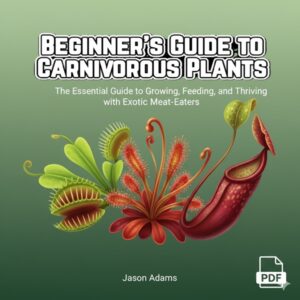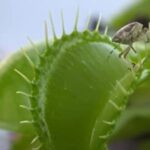As an Amazon Associate, this site earns commissions from qualifying purchases. For more details, click here.
Pitcher plants are versatile and can grow indoors or outdoors with proper care. There are many types available, though they are usually classified into two: nepenthes and sarracenia. Some species are more particular than others, but it is nothing too difficult. To get an idea of the basic requirements to keep pitcher plants alive, read on.
Most pitcher plants require partial or full sunlight with the temperature ranging from 60-85 F (15.5-29 C). Pitcher plants also need moist soil with good drainage, and have to feed on small insects 1-4 times a month.
The easiest way to grow a pitcher plant is to get one that is native to your region. Although these plants can adapt, it will be easier for you if the plant is already accustomed to the environment.
Ready to Grow Carnivorous Plants with Confidence?
Stop guessing and start thriving. Whether you’re raising flytraps, sundews, Nepenthes, or butterworts, this visual-first guide gives you everything you need — from lighting and watering to feeding and seasonal care.
- Beginner-proof diagrams
- Step-by-step routines
- Instant PDF download

Light Requirements
Pitcher plant light requirements may vary by species. Nepenthes prefer partial to full light while sarracenia thrives in strong sunlight. Either way, both will benefit from at least six hours of sunlight each day.
If you are not sure, expose the plant to partial or moderate sunlight. If it looks pale or unhealthy, increase its light exposure. But if the leaves turn brown or look burnt, place it under more shade.
The rule of thumb is that sarracenia pitcher plants prefer stronger light than nepenthes. Use that as a guide but also check the plant to see how it responds to the light. Some pitcher plants naturally grow in rain forests for instance, so they will thrive in partial shade. Other species however, grow in open, sunlit areas.
You can use artificial lights such as fluorescent bulbs. The warm or cool white type is the best choice and should be turned on several hours a day. If you would like to use grow lights our recommendation is Wolezek Plant Lights. These are ideal for both sarracenia and nepenthes.
Temperature and Humidity
Majority of pitcher plants prefer 60-85 F (15.5-29 C). Combine this with adequate sunlight and the plant colors become more vibrant. If the temperature reaches 95-100 F. place the plant under partial shade.
Nepenthes and sarracenia pitcher plants flourish in a sunny, humid environment. Nepenthes should be fine even in a terrarium provided the temperature is ideal. Sarracenia is better suited for outdoors and is rarely if ever grown in a terrarium.
Whether the pitcher plant is indoors or outdoors, try to keep the light, humidity and temperature as close to the ideal setting as possible.
The temperature does not have to be exactly between 60-85 F. A degree or two above or below this will not cause problems. But if it drops too much the plant will slip into dormancy, and if it goes too high the leaves will burn.
One way to counter the heat is by increasing humidity. You can do this by simply keeping the soil moist. You can also move the plant to a partially shaded location, which will reduce heat and increase moisture.
It comes down again to the type of pitcher plant you have and its native habitat. If the plant grows naturally in your region, it should have no problems with the temperature and humidity.
There will be the occasional weather fluctuations, but your pitcher plant will be all right. Check your hardiness zone for details on the growing conditions in your region.
Soil Requirements
Pitcher plants can handle various types of media as long as it is low or free of nutrition. A 1:1 mix of peat moss and perlite will work well. You can also use equal parts sphagnum moss and silica sand.
The soil mix ratio can be adjusted to 2:1, but beginners should use 1:1 or whatever mix instructions came with your plant. Never use regular potting soil or rich fertilizer because that will be harmful to both nepenthes and sarracenia.
An inch of water (2.5 cm) is enough to keep the soil moist. Too much and it could result in root rot and damage the plant.
Just like other plants, nepenthes and sarracenia need good drainage. Keep the moist soil, not soggy. Ensure the container drains and the water does not stagnate.
Stagnant water might breed bacteria, fungi and other plant diseases, so good drainage is a priority. Second, never use tap water. A lot of people use tap water because it is widely available. However it contains minerals that could adversely affect the plant.
Use only purified, reverse osmosis or rainwater. As stated earlier the goal is to simulate the natural habitat of the plant, and that includes water. By using any of these water types you will provide pitcher plants the help it needs to stay alive.
Feeding and Nutrition
Despite their reputation for eating lots of prey, pitcher plants only need a few insects to satisfy their nutritional needs. These plants only have to eat 1-4 times a month to fulfill their requirements.
If your plant is outdoors you do not have to do any food giving. Insects and bugs will come to the traps, drawn by its nectar. As long as the plant is healthy it will have no trouble feeding by itself.
If your pitcher plant has little to no access to prey, manual feeding is required. Any small insect will do, dead or alive. Fish flakes, pellets and other fish food are also fine. We like Fluker’s Freeze Dried Reptile Treats and pitcher plants will benefit from its nutrients.
Remember not to overfeed the plant. Just one insect per week is more than enough. Drop the bug into the pitcher and let the plant take care of the rest.
A well fed pitcher plant will have the liquids required to digest prey. And in case you are wondering, yes there is water in the plant and youcan drink it.
Dormancy
Sarracenia pitcher plants go dormant from November to February. Nepenthes are tropical plants so dormancy is not required.
How to handle this depends on whether your plant is indoors or outdoors.
If your pitcher plant is outdoors year long, it should have no problem with the cold. Assuming the plant is native to the region, it will reemerge in the spring, This is true for nepenthes alata and any tropical pitcher plant.
For indoor pitcher plants, find a cold place where you can store it, like the garage or by the window. Even if they are used to indoor temperature, pitcher plants must still go through dormancy.
As dormancy approaches the plant starts to shed its leaves. They fall off and the plant looks withered. This is nothing to worry about as it is part of the cycle. Prune the dead leaves.
After dormancy your pitcher plant will slowly reemerge. Now is a good time to divide or repot it. You can also do root cutting to propagate it if you like. You can propagate pitcher plants anytime but after dormancy is usually the best.
Tips For Growing Pitcher Plants
Even if you have no experience growing pitcher plants, keeping them alive is not that hard. Here are a few more important tips to help you.
- Do not play with your pitcher plant including nepenthes albomarginata. If you are feeding it, just drop the food into the pitcher. Do not touch the sticky stuff on its rim. It will stick to your skin but washes off easily. However the plant needs that to trap prey.
- Do not be afraid of your pitcher plant. They are safe around humans and pets.
- Lack of light can be fatal to sarracenia and nepnthes. Install artificial lights and use them to augment natural lighting whenever necessary.
- Do not use an air conditioner to increase humidity. This will cause the atmosphere to dry up which is not good for pitcher plants.
- Pitcher plants in terrariums must have sufficient ventilation. While these containers – as well as greenhouses – produce humidity, it might get too hot. Open the terrarium every now and then to let air in.
- For beginners, it is recommended to buy a potted plant. Cultivating pitcher plants from cuttings or seeds needs more work.
If you want to propagate with root or leaf cutting, place it in a bowl with purified or reverse osmosis water. A soil mixture of peat moss and perlite is also suitable. Make certain the soil is moist and the cuttings receive plenty of artificial lighting.
Conclusion
Pitcher plants are not difficult to grow once you learn the basic requirements. It helps to do a bit of research before you buy especially if you are new to carnivorous plant care.

My fascination with carnivorous plants began many, many years ago with Venus Fly Traps. Now I am more than happy to impart what I know with other enthusiasts and those who are curious about meat eating plants.



